|
|
Witch Caves & Salem End Road
Framingham Massachusetts
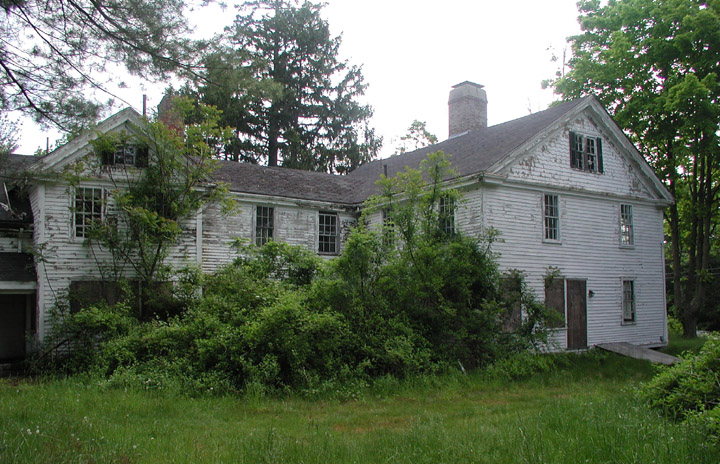
Field Investigation:
25 November 2001, 26 May 2007, & 1 June 2007
by Daniel V. Boudillion
|
Note: this is the full
text of the abbreviated version published in the book Weird Massachusetts
Introduction
Salem was a dangerous and
unforgiving village in 1692. The Witch Hysteria was in full swing
and the simple pointing of fingers was all it took for 19 men and women
to lose their lives at the end of the hangman’s rope on Gallows Hill.
The shadow of the rope fell
particularly harsh on the daughters of William Towne of Topsfield. All
three sisters were soon accused of witchcraft and jailed. Only one made
it out alive. She escaped to Framingham and lived in inhospitable caves
for a winter – Witch Caves –
forming an expatriate community the following spring with other refugees
in a place named after them: Salem End Road.
From Topsfield, to
Salem’s Court, to Salem End Road. The caves are empty and cold now.
Yet the houses they built the following years in Salem End still stand,
and their names woven deep into the community as the years passed:
Nurse, Easty, Cloyes, and Towne.
It was a dangerous time. This
is their story.
Witch Hysteria: A Brief History of the "Sport"
 First, a brief
outline of the Salem Witch Hysteria will help keep the story in the
wider context. An important initial point to know is that Salem Town
and Salem Village were two different, though adjacent, worlds. One was
a small thickly-settled seaport town, busting with commerce, the other a
large rural area of farms and woodlots. The witch hysteria almost
exclusively took place in Salem Village (see
map &
index), renamed the Town of Danvers in
1752. First, a brief
outline of the Salem Witch Hysteria will help keep the story in the
wider context. An important initial point to know is that Salem Town
and Salem Village were two different, though adjacent, worlds. One was
a small thickly-settled seaport town, busting with commerce, the other a
large rural area of farms and woodlots. The witch hysteria almost
exclusively took place in Salem Village (see
map &
index), renamed the Town of Danvers in
1752.
The Reverend
Samuel Parris was the minister of Salem Village. His household included
a West Indian slave named Tituba who was often given the task of
overseeing the two young girls. During the long winter of 1691–1692,
she regaled the two girls, Elizabeth Parris, nine, and her cousin
Abigail Williams, 11, with tales of her girlhood in the Barbados. The
stories were so entertaining that soon the girls invited their friends
to the kitchen hearth to join in. Soon a regular little group was
meeting and as the conversations began to revolve around Tituba’s
knowledge of forbidden subjects such as voodoo and fortune telling, it
became an exciting adventure.
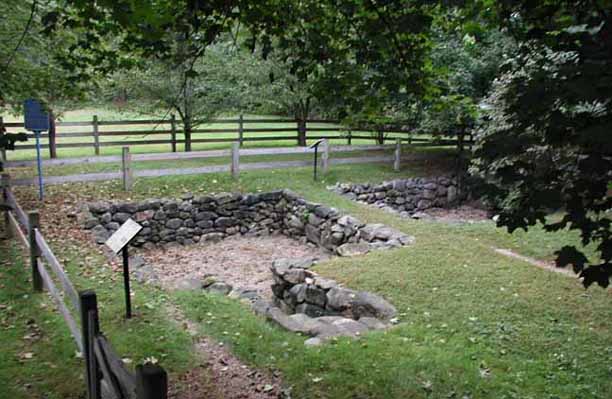
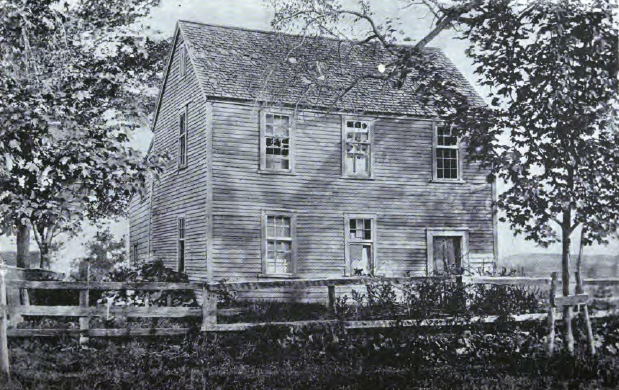
Samuel Parris Parsonage: excavated
foundation on left, structure in 1892 on right
Danvers
Elizabeth began
having seizures and uttering strange noises early in January of 1692,
followed closely in this by the older Abigail. Alarmed, Parris called
Dr. Griggs, who declared in mid-February that the girls were "under
the evil hand."
Thus the idea that witches were afoot in Salem Village was introduced
for the first time. After repeated demands by Parris for the girls to
name the witches responsible, they named Tituba, and two unpopular
women, Sarah Good and Sarah Osborne. When questioned, Tituba said Good
and Osborne were witches and been one with them until she changed her
ways.
Other Salem
Village girls began complaining of being "afflicted"
by witches and soon a group of ten girls were actively involved as the
primary litmus test of "witchcraft."
If they convulsed in the presence of a person, that person was a witch.
In short order fingers were pointed and the accusations began rolling
out in earnest by March 12, 1692, resulting in arrests, trials, and
ultimately executions. "Sport,"
the girls afterwards said of it, "we
must have our sport."
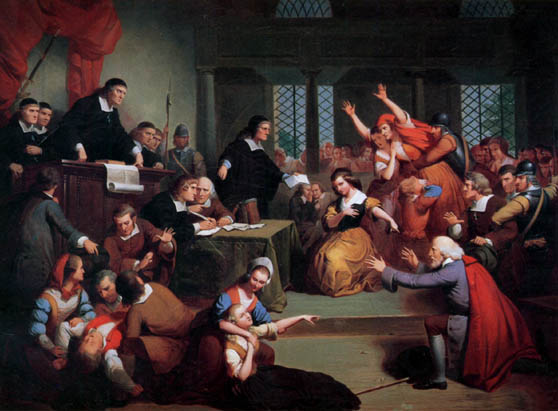
"Trial of George Jacobs, August 5,
1692"
Thomkins Matteson, 1855
Their sport became
the highlight of the trials, as did describing invisible events. This,
called "spectral
evidence,"
was the sole evidence that sent their neighbors to slow death in the
hangman’s noose.
A Grand Conspiracy Unmasked
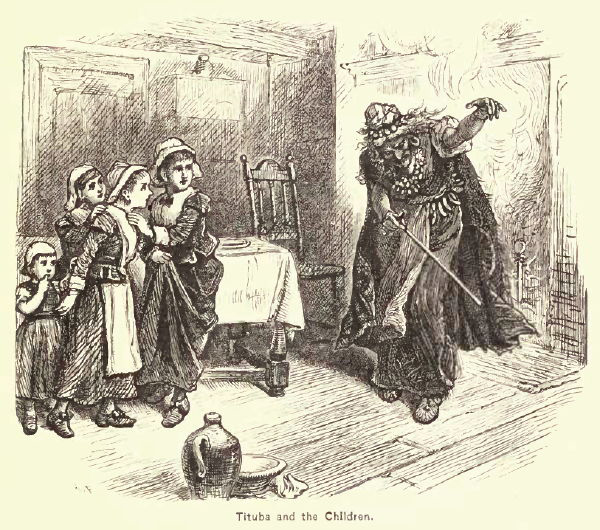 The Towne sisters story begins
in Topsfield. Let’s commence by painting the witchcraft picture via
another Topsfield family, the Hobbs, William, Deliverance, and daughter
Abigail. All three were accused and brought to trial. Both Deliverance
and Abigail confessed. Abigail, an odd girl by all accounts, confessed
quite willingly and with obvious relish. The Towne sisters story begins
in Topsfield. Let’s commence by painting the witchcraft picture via
another Topsfield family, the Hobbs, William, Deliverance, and daughter
Abigail. All three were accused and brought to trial. Both Deliverance
and Abigail confessed. Abigail, an odd girl by all accounts, confessed
quite willingly and with obvious relish.
Deliverance’s confession in particular shook
Salem Village to its very roots. According to her, there were "some
three hundred of more witches in the county and that their object was
the destruction of Salem Village."
These were frightening words - the worst Puritan fears realized. Rage,
horror, and alarm followed this confession.
William Barker of Andover
confessed that "the Devil’s design was to destroy Salem Village …
to begin at the minister’s house … and to destroy the Church of God and
set up Satan’s Kingdom."
(Oddly, there actually is a "Satan’s
Kingdom" in Massachusetts, two of
them in fact: one in Westwood and a second in Northfield.)
A further outrage is that this
diabolical conspiracy held its meetings in their minister’s fields.
Deliverance’s daughter Abigail, who had "had sold herself body and
soul to the Old Boy," filled in the details to a hushed and anxious
audience. She described a "witch meeting, in the field near Mr.
Parris's house," in which Mr. Burroughs, a former Salem Village
minister, acted a conspicuous part.
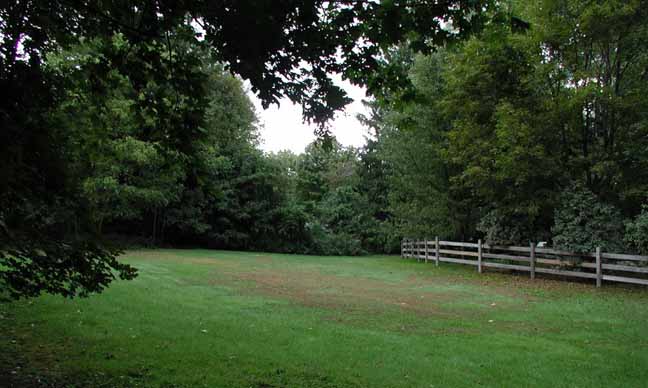
"Witch Grounds" near the Parris
Parsonage
Danvers
She swore that "Mr. Burroughs
had a trumpet which he blew to summon the witches to their feasts" and
other meetings "near Mr. Parris's house." This trumpet, according to
her, had a sound that reached over the country far and wide, sending its
blasts to Andover, and wakening its echoes along the Merrimack, to Cape
Ann, and the uttermost settlements everywhere. The witches would
hearing this, would mount their brooms and fly to Mr. Parris's orchard,
just to the north and west of the parsonage.
Its sound was not heard by any ears other than those who were
confederates with Satan.
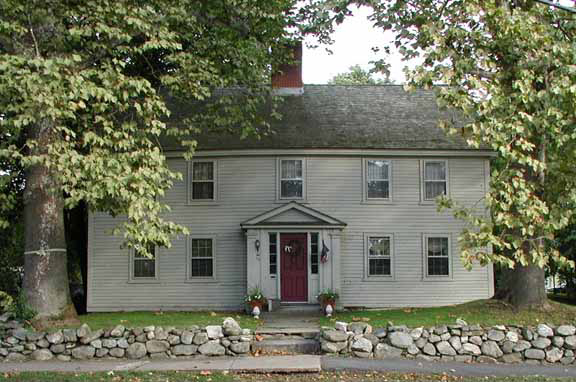
Ingersoll Ordinary: Where the accused
were first brought
Danvers
Revealed was the
Devil’s secret war, the very point and center of it being Salem
Village. The very Colony and Puritanism was at stake in a grand
conspiracy against God and man.
"The horror, alarm and rage
which must have followed such confessions can only indeed be imagined by
those who know the religious tendencies and convictions of the Puritans
at that day."
Being aghast with these revelations, and in
the grips of hysteria, it is no wonder that when the Towne sisters were
dragged into court, their pleas were given little heed and their fates
sealed from the moment of their arrest. They had been accused
(tantamount to a confession in the strange ways of Puritan courts of the
time) and thus were traitors, working destruction against God and God’s
community on earth.
It would prove to be a remarkable and ghastly
year. "Silence,
darkness, mystery, diabolism - all brooded over it and lent their aid."
The Daughters of William Towne
William Towne and his wife
Joanna emigrated from Great Yarmouth, England, to the Bay Colony
sometime between 1634 and 1639, settling on Main Street in Topsfield,
Massachusetts. They had seven children, four of them daughters. The
eldest daughter married and remained in England, but the two younger,
Rebecca and Mary, emigrated to the Massachusetts Bay Colony with their
parents. The youngest, Sarah, was born in Topsfield in 1642.
William was a small farmer in a rural frontier
town to the northwest of Salem Village. The sisters were raised in the
family house located near the intersection of South Main Street and
Salem Street.
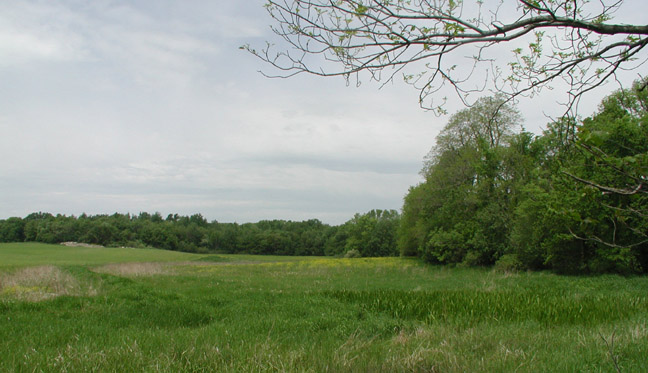
William Towne Homesite, Main Street,
Topsfield
William passed away in 1672 and
their mother Joanna died in 1682. Both were buried in Pine Hill
Cemetery but no markers remain. When the estate was settled in 1683,
the land was divided equally between the sons, John, Jacob, and Joseph.
The "moveables" were divided equally between the three
daughters.
In 1692, all three Towne sisters
lived along the road that traversed through Salem Village, from Salem
Town to Topsfield, known as High Street in Topsfield. Rebecca and Mary
were in Salem Village, Rebecca near the Salem Town line, and Mary near
the Wenham line. Sarah lived in Topsfield near the center of town.
Rebecca Nurse
The eldest daughter, Rebecca, or Rebecka as
she spelled it, was born in Great Yarmouth, England, in 1622. She
married Francis Nurse, another English immigrant, in 1644, when he was
26 and she was 22 years old. For the next 30 years they lived in a
small way in one of the most thickly settled parts of Salem Town, on the
Wooleston River neck near where the old ferry (and now bridge) crosses
to Beverly. (Number
95 on Upham Map)
Francis was a tray maker and
artisan by trade, but like most people of the time, he also worked a
small farm as well. At age 60, in an amazing stoke of good fortune and
sharp dealing, he managed to acquire the
300-acre Bishop Farm in Salem Village for no money down. In one
fell swoop in 1678 he went from a small farmer and artisan to one of the
largest land owners in the area. The Nurses took proud possession of
the lands and the large saltbox house, which still stands today and is
known as the Rebecca Nurse house.
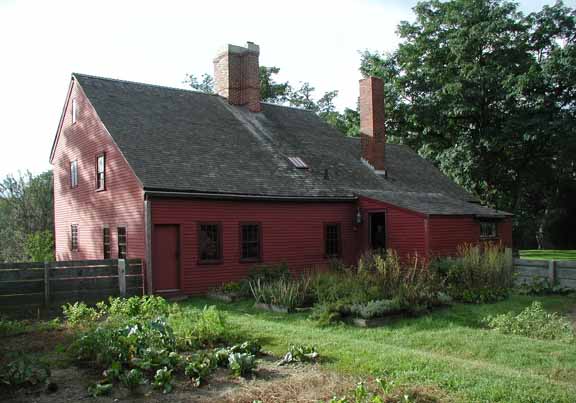
Rebecca Nurse house
Danvers
The witchcraft
hysteria had started in the household of Reverend Samuel Parris, a
controversial figure in Salem Village for a number of years, around whom
political factions swirled. The fault lines of the hysteria seemed to
revolve around loyalty to Parris or
displeasure with
him. One group, became the accusers, the other, the displeased,
becoming the accused.
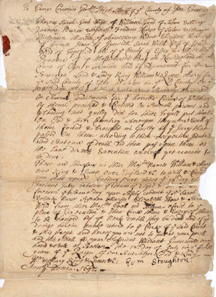 Indeed, so bitter had the
ministerial issues become that in 1691 the Nurse family began "absenting"
themselves from Sabbath meetings in protest. This was a move that did
not reflect well on them in the following year. Indeed, so bitter had the
ministerial issues become that in 1691 the Nurse family began "absenting"
themselves from Sabbath meetings in protest. This was a move that did
not reflect well on them in the following year.
In 1692, at the time of the
accusations, Rebecca was 71 years old, a respectable and even saintly
grandmother who had raised eight children. However, on March 23, a
warrant for her arrest for practicing witchcraft was issued and on the
following day she was arrested and dragged form her sickbed to the cold
stone prison in Salem. She was then transferred to a similar prison in
Boston. Petitions were signed on her behalf to no avail, and she was
transferred back to Salem for trial in May. She was found not guilty by
a jury, but so unhappy was the Chief Judge that he asked the jury to
reconsider. Abigail Hobbs, the self-proclaimed young witch, remarked
upon the not guilty verdict, "What? She is one of us." The
next verdict came in guilty.
Rebecka Nurse Death Warrant
Rebecca in 1692, was
excommunicated and sentenced to death. A reprieve was granted, then
denied. On July 19, she was publicly hauled in a cart from Prison Lane
in Salem (now St. Peter’s Street), down Essex and Boston streets, and
over Town Bridge. There on a low rocky hill, she was hanged by the neck
until dead.
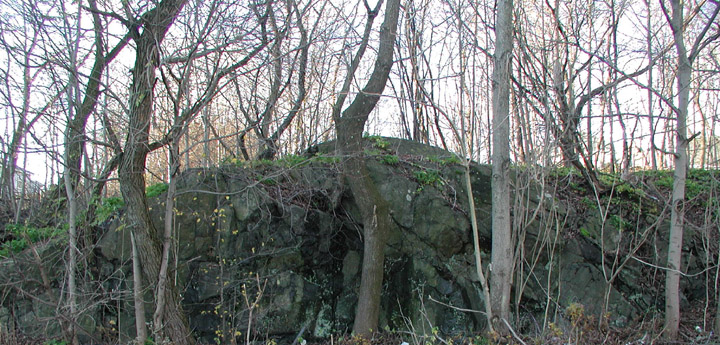
Gallows Hill, Salem
There were no gallows. She was
simply stood on the back of the cart, the rope slung over a tree limb
and around her neck, and the cart driven out from under her. It is
recorded that the Salem witch hangings were slow agonizing deaths of
asphyxiation. Friends and family members would pull on the victims legs
to help bring about a speedy end.
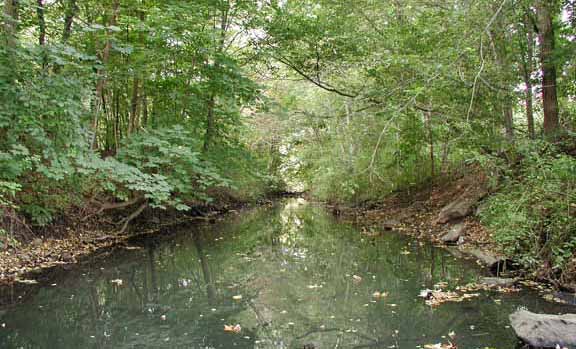
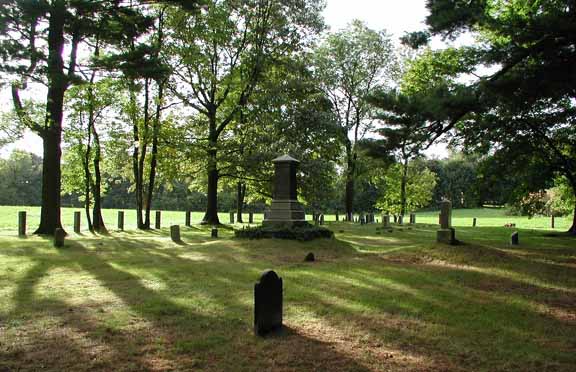
Crane Creek & Nurse Farm Cemetery,
Danvers
Denied a proper burial, she and
the others hung that day were dumped in a crevasse on the side of the
little hill. That night, her youngest son Benjamin, who was living at
the Nurse homestead with his pregnant wife, retrieved his mother’s body
by boat and rowed her back to the Nurse farm via Crane Creek where she was buried that
night in a secret grave. Back then, the North River was a wide bay, and
the water extended to the ledge behind the present day location of
Walgreen’s near where the hangings took place.
|
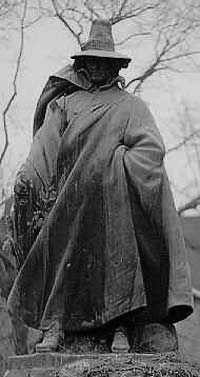 Gallows
Hill: Where Were the Witches Really Hung? by D. V.
Boudillion Gallows
Hill: Where Were the Witches Really Hung? by D. V.
Boudillion
The story of 18 people
accused as witches in the 1692 Salem Witch Hysteria ends as victims at
the end of a hangman’s rope on Gallows Hill, otherwise known as Witch
Hill or Witchcraft Hill. You would think such a public and awful
event at that spot would have made such a huge impression on people that
the location would live forever if only in infamy. Yet today, the exact
location of the hangings, and even which hill is Gallows Hill, is not
precisely known.
The town of Salem did set aside
a public park but there is still historical debate about the location of
the site and the clues lead elsewhere. Let us see where those clues
lead. . .
To read the entire
article,
click here.
|
To add insult to injury, the families of the executed were billed for
all the prison and execution costs, including leg irons and the
hangman’s fees. No food or bedding was given to the prisoners other
than what their friends and families could provide them.
Mary Easty
The middle sister, Mary Easty
(also recorded as Esty) was born in Great Yarmouth, England, in 1634.
She married Issac Easty of Topsfield in 1655 at the age of 21. They had
nine children and lived across the street from her parents in Topsfield
near the center of town. Issac was a well known figure in town and had
served as Selectman. (Number
2 on Upham Map)
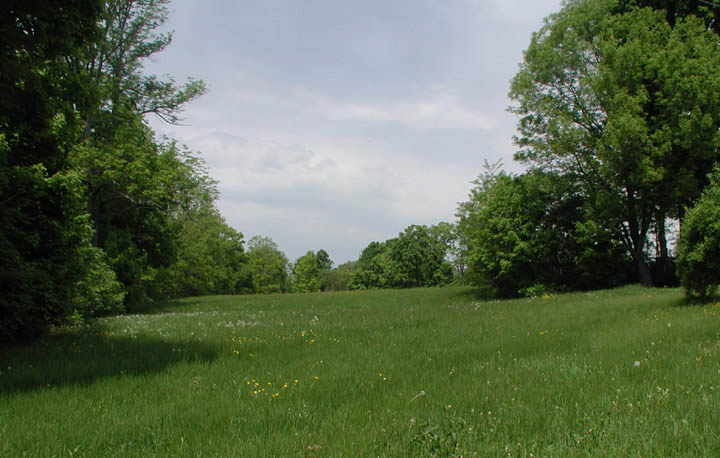
Issac & Mary Easty Homestead site,
Topsfield
In 1692 Mary was 58 years old.
Within a few days of her eldest sister Rebecca’s arrest on March 23, her
younger sister Sarah was arrested as well. It was only a matter of time
before the fingers started pointing at the third Towne sister. On
April, 22 Mary was arrested in her
Topsfield home and held for trial in Salem Town. There was uncertainly
about her guilt and she was released on May 18th and returned
home, however, her homecoming was brief. She was arrested again on May
20th from her son’s house in Topsfield on what was
thenceforth known as Witch Hill and was dragged off in irons in the
middle of the night.
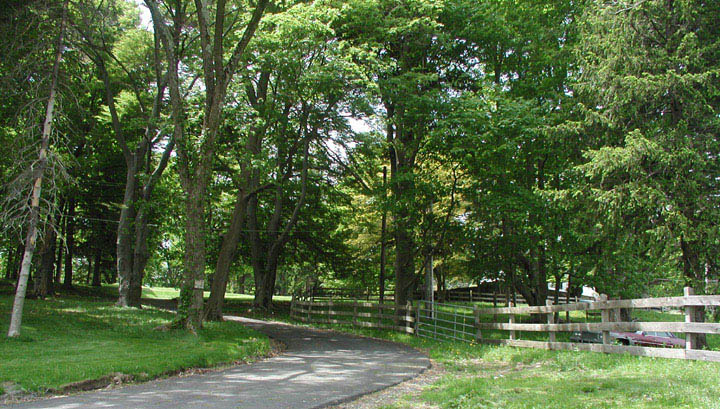
Witch Hill in Topsfield
In a sad turn of events, her
grandniece Rebecca Towne, who was 24 at the time, became one the "afflicted
girls" who testified against her in court. Rebecca was Mary’s
brother John’s granddaughter. Rebecca Towne also testified against her
other grandaunt, Sarah Cloyes as well. Both Rebecca’s father and
grandfather had passed away well before the trials; her father died when
she was only 10 years old. Perhaps this shameful act would not have
occurred had either men been alive.
Like her elder sister, Mary
Easty was convicted. She was hung to death on the low rocky hill on
September 22, in what is recorded as a "chill and rainy" day.
Sarah Bridges Cloyes
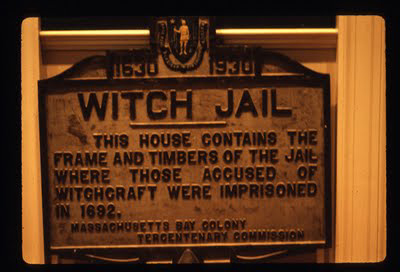 The youngest Towne sister, Sarah
Bridges Cloyes (also recorded as Clayes)
was born in Topsfield in 1642. She married Sargeant Edmund Bridges of
Topsfield in 1659 at age 17. Edmund, a lawyer, was part owner of a
wharf on the Salem waterfront and had also procured a license to sell
alcohol. According to McMillen, "Sarah became
involved with running the waterfront tavern while her husband carried on
with his legal practice, often appearing in Salem quarterly courts as
attorney, arbitrator and witness." The Bridges lived in Salem Town and
had 7 or 8 children, but Edmund died 1682 at the disappointing
age of 45. This was a difficult year for Sarah as both her mother and
husband died. The youngest Towne sister, Sarah
Bridges Cloyes (also recorded as Clayes)
was born in Topsfield in 1642. She married Sargeant Edmund Bridges of
Topsfield in 1659 at age 17. Edmund, a lawyer, was part owner of a
wharf on the Salem waterfront and had also procured a license to sell
alcohol. According to McMillen, "Sarah became
involved with running the waterfront tavern while her husband carried on
with his legal practice, often appearing in Salem quarterly courts as
attorney, arbitrator and witness." The Bridges lived in Salem Town and
had 7 or 8 children, but Edmund died 1682 at the disappointing
age of 45. This was a difficult year for Sarah as both her mother and
husband died.
Even worse, three months after her husband’s death, "The widow of
Edmund Bridges and her children were ordered out of Topsfield by the
constable, September 12, 1682." We don’t know why they were
ordered out of Topsfield but it is reasonable to assume that in an
impoverished condition she had returned to her family there after the
death of her husband in Salem Town.
Sarah quickly remarried to Peter
Cloyes in 1682, at the age of 40, a second marriage for them both.
Although records differ, it is believed they had either no children, or
none who survived to adulthood. They lived on Peter Cloyes’s farm in
Salem Village near Wenham. (Number
43 on Upham Map)
In 1692, Sarah was 50 years
old. The Cloyes were members of the Salem Village congregation of Rev.
Parris. Like the Nurse family, the Cloyes were also displeased with
issues revolving around the Parris ministry and by 1692 were also "absenting"
themselves from Sabbath. On April 3rd, Sarah walked out of a
sermon by Parris when he announced his text as, “Have
not I chosen you Twelve, and one of you is a Devil.” The wind caught
the door as she left, slamming it.
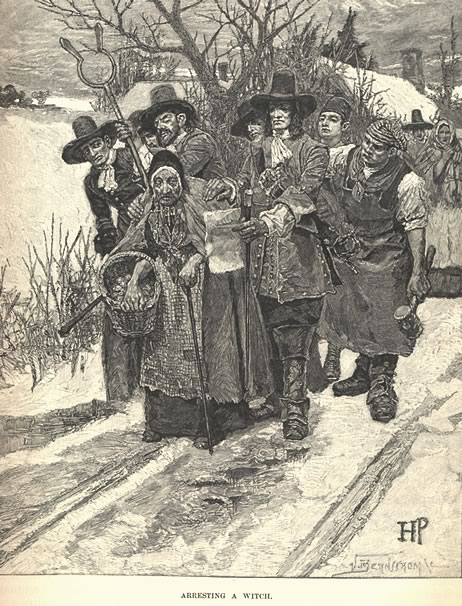 The following day
a complaint of Witchcraft was brought against Sarah, and she was
arrested on April 8th. She was examined and refused to
confess. She was fitted with hand and leg irons and placed in
Salem
jail with her sister Rebecca. Later she was removed to a Boston prison,
and then with her sister Mary to Ipswich, and then back to Salem again. The following day
a complaint of Witchcraft was brought against Sarah, and she was
arrested on April 8th. She was examined and refused to
confess. She was fitted with hand and leg irons and placed in
Salem
jail with her sister Rebecca. Later she was removed to a Boston prison,
and then with her sister Mary to Ipswich, and then back to Salem again.
Two weeks after
Rebecca’s execution in July, a charge of 20 pounds sterling was
presented by the blacksmith "for
making fouer payer of iron ffetters and tow payer of hand Cuffs and
putting them on to ye legs and hands of Goodwife Cloys."
Sarah’s grandniece
Rebecca Towne testified against her, just as she testified against Mary,
and an indictment followed. "On the following day an indictment was
made out against Sarah Cloyes, wife of Peter Cloyes of Salem, in the
County of Essex, husbandman, that 'in and upon the ninth day of
September --- in the year aforesaid and divers other days and times as
well before as after, certain detestable arts called witchcraft and
sorceries, wickedly, maliciously and feloniously hath used practiced and
exercised... in, upon and against one Rebecca Towne of Topsfield in the
County of Essex aforesaid Rebecca Towne... was and is tortured,
afflicted, consumed, pined, wasted, tormented, and also for sundry other
acts of witchcraft by the said Sarah Cloyes."
Arresting a Witch, by Howard Pyle, 1883
Mary was executed in September
two weeks following Sarah’s indictment, as the wheels of injustice
remorselessly ground away.
However, unlike her elder
sisters Rebecca and Mary, Sarah’s husband did more then just gape at
their "witch" wives in amazement at the trails. Peter was
truly devoted and toiled diligently for her release. Danvers Church
records note his devotion to her that summer:
"......Brother Cloyse hard to be found at home being often with his wife
in Prison in Ipswich for Witchcraft...."
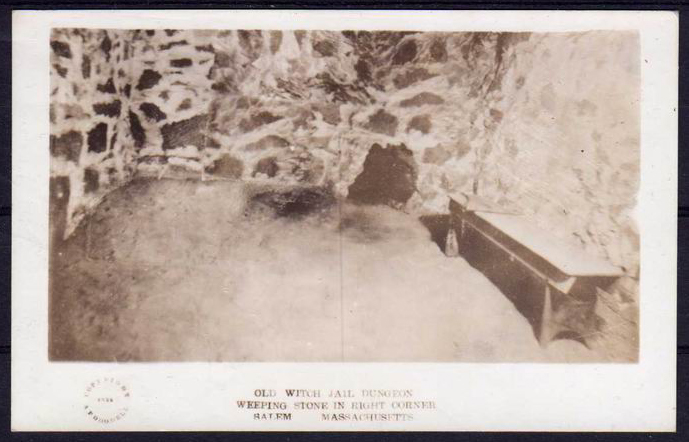
Old Witch Jail Dungeon
Weeping Stone in Right Corner
Salem Massachusetts
When all the legal
maneuvers failed, with Sarah’s sisters having been hung as witches,
Peter did the only intelligent thing as the shadow of the hangman’s rope
drew near in the new round of trials of January 1693. He broke Sarah
out of jail and fled south.
Escape & Flight
First, we have to acknowledge that the Daily
News Record in 1993 claims that in early January of 1693, that the
Superior Court dismissed the charges against Sarah; Peter simply paid
the prison fees and she was released. Following this they moved to
Marlborough, according to the paper.
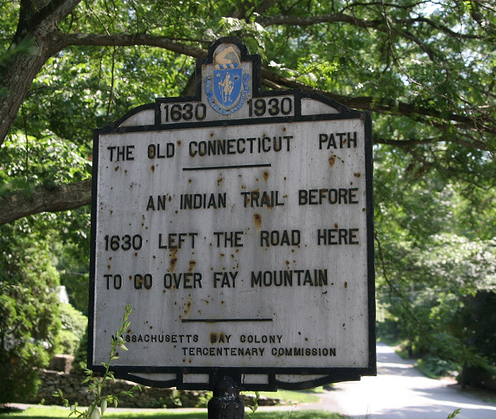 But tradition and earlier
reliable sources tell us otherwise. According to the book
Framingham Historical Reflections, "Clayes was imprisoned in Ipswich and
smuggled out along with friends who had come to visit her," and
thence, according to the History of Framingham, "conveyed by night
to Framingham." But tradition and earlier
reliable sources tell us otherwise. According to the book
Framingham Historical Reflections, "Clayes was imprisoned in Ipswich and
smuggled out along with friends who had come to visit her," and
thence, according to the History of Framingham, "conveyed by night
to Framingham."
Framingham historian Stephen
Herring adds in 1999 that "it’s known that she somehow
escaped from a makeshift ‘jail’ in Ipswich – probably a farmer’s shed –
and made her way with her husband towards
Danforth’s property," a safe area in what is now
Framingham.
Certainly Peter
had been petitioning for a recognizance for his wife and it is always
possible they simply skipped bail.
Old
Connecticut Path, Westborough, Massachusetts
However they managed Sarah’s escape, it was
deep in a New England winter that they made their way southwest to
Framingham, then known as the Danforth Plantation, and marked in old
records of the times as "the
wilderness."
This is full 40 miles as the crow flies, but they did not undertake such
an unlikely journey on speculation. They knew somehow they had a safe
(albeit cold) haven waiting at Danforth Plantation in the wilderness.
Perhaps the friends that helped smuggle Sarah out were part of a wider
but fledgling "underground
railway"
out of Salem.
The only cross-country roads in 1693 were the
early bridal paths which followed the old Indian trails. The only such
path going southwest towards Framingham was the
Old Connecticut Path.
This wound its way from Watertown southwesterly through the wilderness
lands until eventually reaching the shores of the Connecticut River near
Hartford. Peter knew Old Connecticut Path, having grown up in
Watertown. It was the main path southwest. In fact, it was the only
path southwest. He had probably walked the eastern end extensively as
young man.
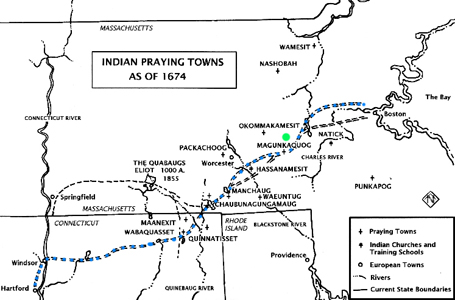
Old Connecticut Path
Trailhead just Northeast of Boston at
Watertown, Danforth Plantation is marked in Green
click to
enlarge
The Cloyes would have carefully picked their
way to Boston by night, avoiding encounters. It is unlikely they would
have been able to manage this portion of the trek without the assistance
of the friends who helped smuggle Sarah out of Ipswich jail. For one
thing, Sarah wasn’t well.
Having reached Boston safely, they would have
gone west to Watertown and picked up the trailhead of the Old
Connecticut Path. The Cloyes traveled this path southwesterly for about
ten miles, entering the eastern side of the new Town of Sudbury (now
Wayland), following the lower contour of Reeve’s Hill, well above the
icy wet river meadows, and then crossing the frozen Cochituate Brook at
the ancient wading place. Shortly thereafter they would have entered
what is now the northeast corner of Framingham, crossing the Sudbury
River at an ancient fordway, and then preceding southwest, a five mile
journey as the crow flies from Wayland.
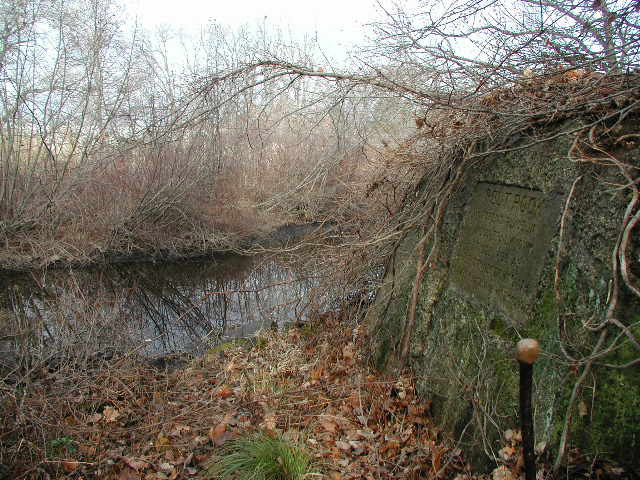
Pout Rock & ford on the Old Connecticut
Path
Sudbury River, Ashland
Up to about 1690
the earliest settlers of the Danforth Plantation built on or near the
Old Connecticut Path, so not long after fording the Sudbury River, the
Cloyes would have seen the welcoming lights of several existing
homesteads. Or perhaps not so welcome. Sarah was a condemned witch
from a proven witch family – a notorious consort of the devil - and her
husband an accomplice in her escape. Criminals both, they probably
swung clear through the cold of the harsh winter night. Better to wait
until spring and official grace
from
Danforth himself before showing themselves.
Refuge at the Danforth Plantation
It’s a strange thing, but
Danforth Plantation
where the Cloyes sought asylum was owned by one of the early Judges at
the Salem Witch Trials. Deputy Governor Thomas Danforth had sat on the
early Tribunal. But he had left the tribunal in May, several months
before the hangings began, harboring a secret disgust and ill-ease with
the proceedings. In fact, Judge Sewall, a prominent witch trial judge,
wrote in his diary that Danforth had done much to put an end "to
the troubles under which the country groaned in 1692."
It may also be that Danforth’s departure from
the tribunal in May might have to do with the fact that he was Deputy
Governor under Governor Bradstreet, and the Governorship changed hands
to Sir William Phips on May 14, 1692. He may simply no longer have had
the position or authority to sit on the tribunal. Judging by his later
actions, this may have been a disastrous loss for the accused.
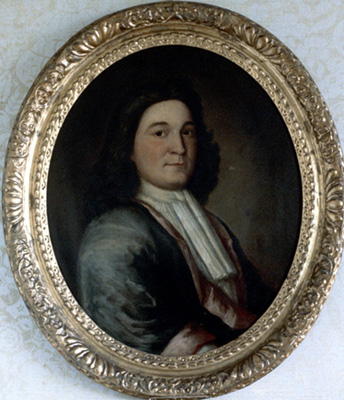
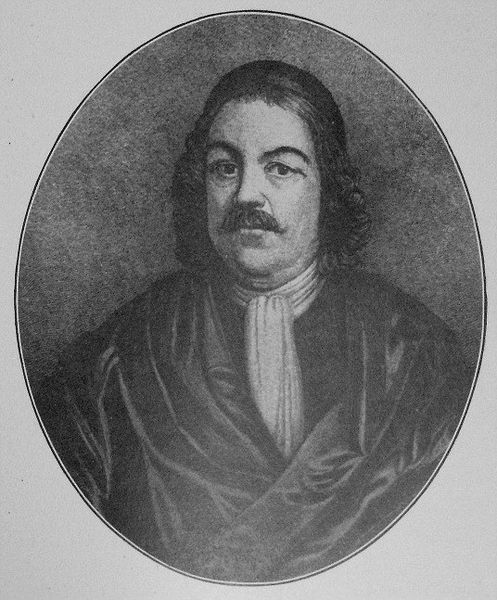
Sir William Phips & Governor Simon
Bradstreet
Danforth had acquired at least
16,000 acres of land in Colonial government grants between 1660 and
1662. This was originally known as Danforth Farm or Plantation, and
later renamed Framingham. In a 1999 newspaper
article, Herring is quoted as saying he believes that Danforth was the
secret "guardian angel"
who helped the Cloyes, and more than a dozen other escaping Salem area
families who were "all related by
blood or marriage," to find refuge
on his Plantation.
Danforth subsequently turned over more than
800 acres to Salem families seeking asylum and safety, including the
Towne, Nurse, Bridges, Easty, and Cloyes families. The new settlement
quickly became known as Salem End Road. They came fearing for their
lives, seeking a safe haven, and found it on Danforth’s Plantation,
living in safety on his land as a reparation for their treatment in
Salem.
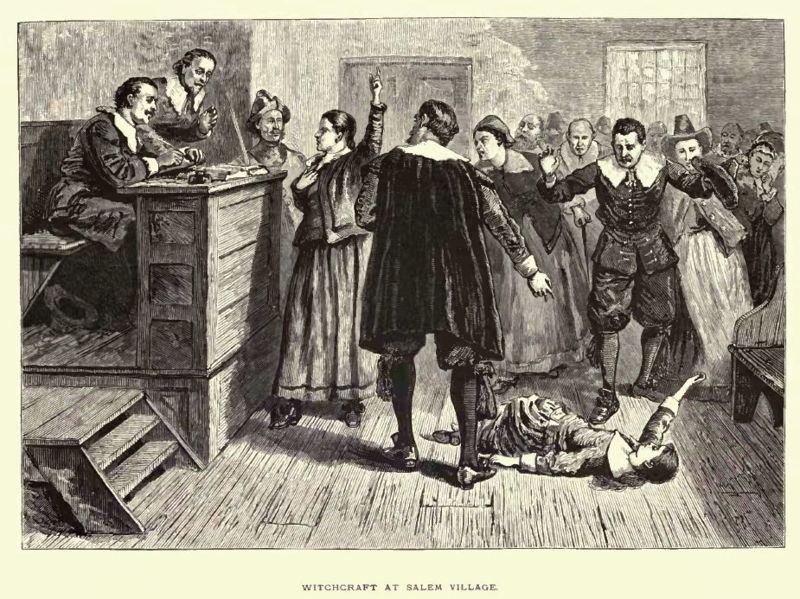 The Cloyes’ escape and deliberate journey to the Plantation, the
subsequent steady arrival of Salem Witch Trial refugees and the awaiting
farmland, all smacks of a shadowy hand moving behind the scenes, and a
loose network of helpful friends. In short, there are glimmers of a
primitive "underground
railway"
in operation, quietly moving Towne sisters and related families out of
Salem Village to a more hospitable locale. The Cloyes’ escape and deliberate journey to the Plantation, the
subsequent steady arrival of Salem Witch Trial refugees and the awaiting
farmland, all smacks of a shadowy hand moving behind the scenes, and a
loose network of helpful friends. In short, there are glimmers of a
primitive "underground
railway"
in operation, quietly moving Towne sisters and related families out of
Salem Village to a more hospitable locale.
Danforth had been on the Tribunal through May, long enough to have
observed the character of all three Towne sisters. Records show that
the three sisters repeatedly behaved with dignity, piety, firmness and
good character to such an extent that the magistrates hesitated
repeatedly with their cases. Rebecca was brought in Not Guilty, only to
be re-deliberated until Guilty. She was reprieved, only to have it
denied. Petitions were signed on her behalf. Mary was cleared only to
be re-accused and rearrested. The minister of Topsfield vouched for
both Mary and Sarah, but to no avail. Sarah wrote elegant appeals that
were ignored.
It seemed the fates were blindly determined that they should die
regardless of the laws of man and god. Many were rightfully impressed
with the Towne sisters and deeply distressed with the proceedings.
Danforth seems to have been one of those and afterwards made it his
business to take in and see to the welfare and reparations of the
surviving Towne sister’s families, starting with Sarah (Towne) Cloyes
herself. Ironically, in Arthur Miller’s play The Crucible, Danforth
was unflatteringly portrayed as a "Black-robed
paragon of Puritan rectitude."
However it was
that the Danforth haven become known to those fleeing the accusations
and executions, a large boulder on Salem End Road was said to be the
official landmark that that signaled escaping families that they were on
the Plantation and safe at last.
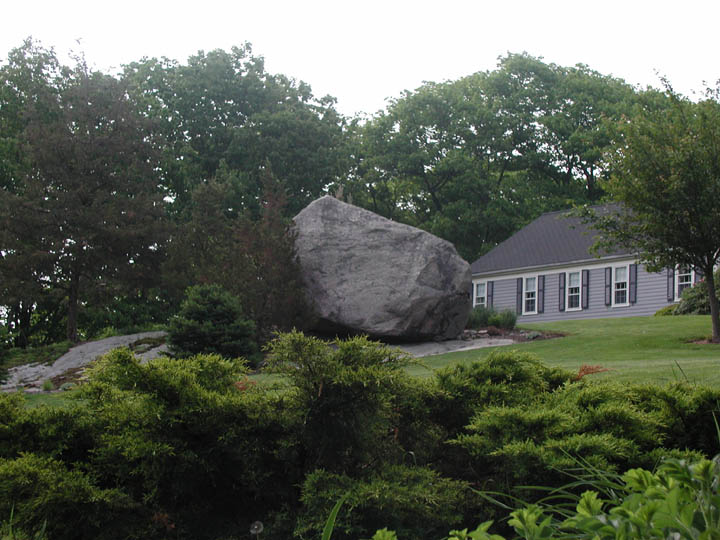
Boulder marking Danforth Plantation
Salem End Road
A Cold Winter in the Rocks
It is unknown exactly where the
Cloyes spent that first bitter winter in Danforth Plantation. But local
legend has always claimed it was in a network of small boulder caves in
a steep cliff face (Witch Cliffs) on the Framingham-Ashland
line. These caves have always been called Witch Caves. (GPS
coordinates: 42.27630N, -71.46930W.)
I have explored
these caves twice; once in 2001 and more recently in 2007. One thing I
can assure above anything else is that these caves are small, cold,
drafty, and hard. Little improvement over the stone cell of Salem Town
Prison. Of course, I am sure they would have blocked the holes tight
with snow, stuffed the place full of leaves, made spruce-bough beds,
built a lean-to of logs in front of the entrance, and made a door flap
with birch bark. That’s pretty much what any outdoorsman would do faced
with such a situation. Add a fire under the lean-to, and it’s a slight
much better, and warmer, than you might expect. Peter Cloyes had been
an Indian fighter in the 1675-76 King Philip’s war and lived in Wells,
Maine, and was likely a rough and tumble woodsman of necessity. I don’t
think he would have had much trouble turning the caves into a snug
burrow for the winter.
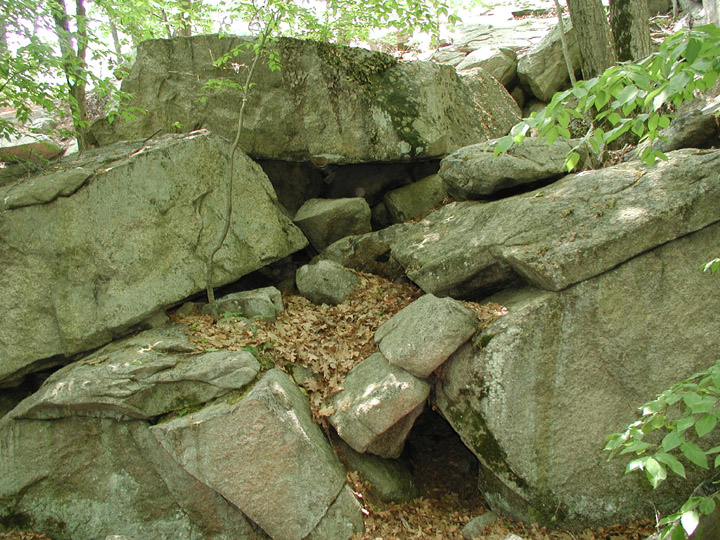
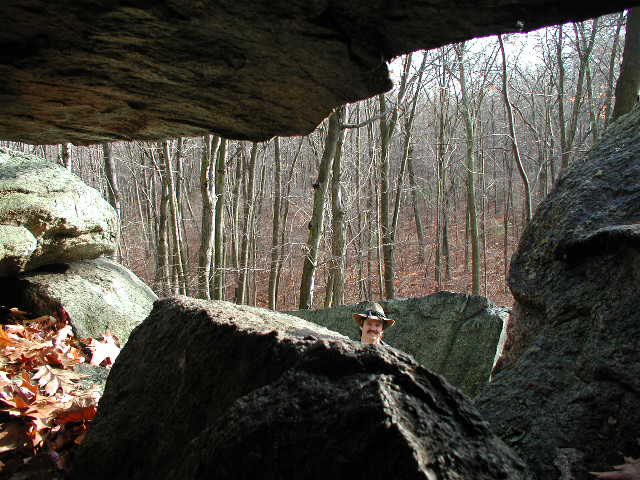
Witch Caves in Witch Cliffs ~ Looking
out of a Witch Cave across the ravine.
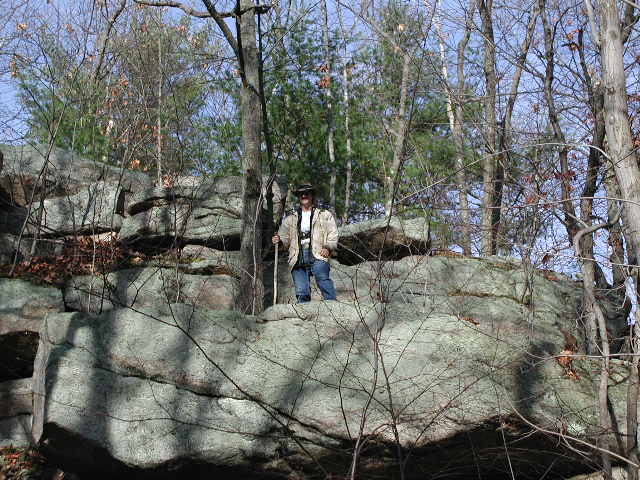

Ed Cornish on Witch Cliffs November
2001 ~ looking down from top of Witch Cliffs June 2007.
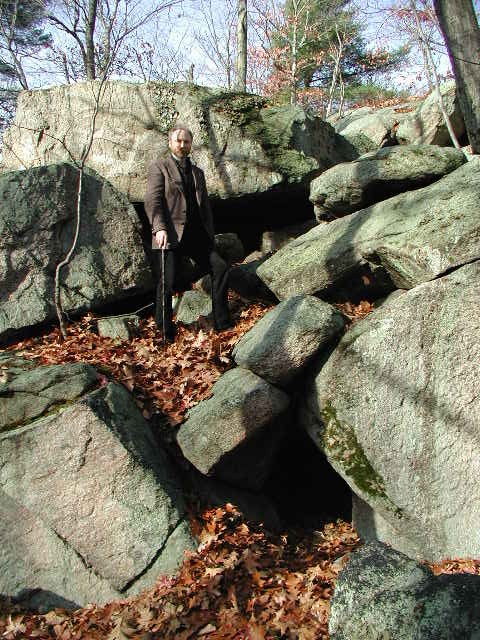
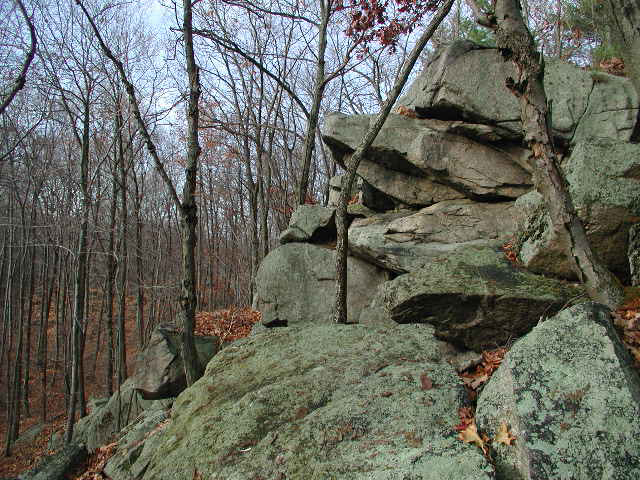
The Author at Witch Caves & Cliffs
November 2001
Sarah was hardly
in good health when she escaped Ipswich. She was 50 years old, and had
spent nine months in
various jails routinely shackled in irons, in unheated quarters,
subsiding only on what her family was able to provide her. She emerged
from jail that cold winter night a sick and fragile woman. She was very
lucky to have survived the ensuing winter in the caves.
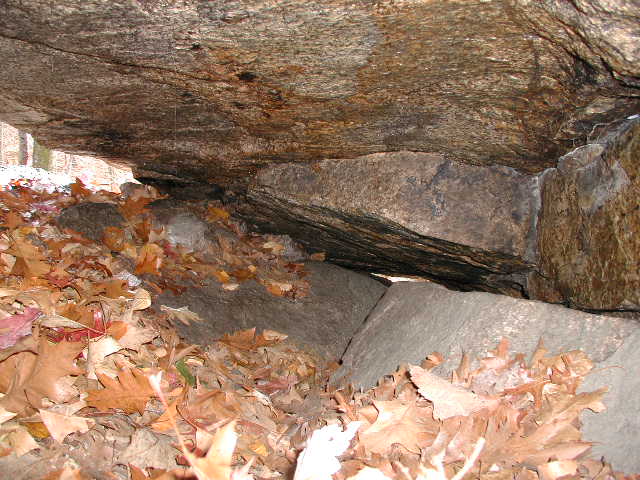
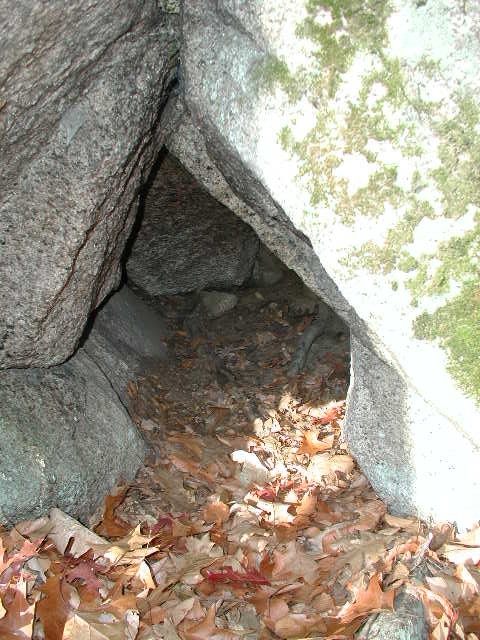
Interior of Witch Caves in Witch Cliffs
In the 1985 PBS mini-series
Three Sovereigns for Sarah, it is argued that she only survived her
imprisoning because five months of her term was in Ipswich, a makeshift
private affair in an old barn, not the ghastly Colonial stone cells of
Salem and Boston.
Other Escapees: Nahant and Rockport
The Cloyes weren’t the only ones
that thought to get of Salem Village fast and caves seem to have been a
popular hideout. For example, in Nahant there is a low boulder-stone
cave, more like a chamber really, locally known as the
Witch Cave. Robert Ellis Cahill, the
former Sheriff of Salem, reports in Ancient Mysteries that it is where a
woman accused of witchcraft supposedly hid with her daughter in 1692.
The name of the woman is not recorded.
Another mystery escapee – this
one recounted in Skinner’s Tales of Puritan Land in 1896 – is the "blue-eyed
maid of Wenham, whose lover aided her to break the wooden jail and
carried her safely beyond the Merrimac, finding a home for her among the
Quakers." I have searched the records and am unaware of any woman
from Wenham who was accused of witchcraft let alone jailed. But it’s a
nice story nonetheless.
Skinner also tells us of "Miss
Wheeler, of Salem, who had fallen under suspicion, and whose brothers
hurried her into a boat, rowed around Cape Ann, and safely bestowed her
in the "the witch house" at Pigeon Cove."
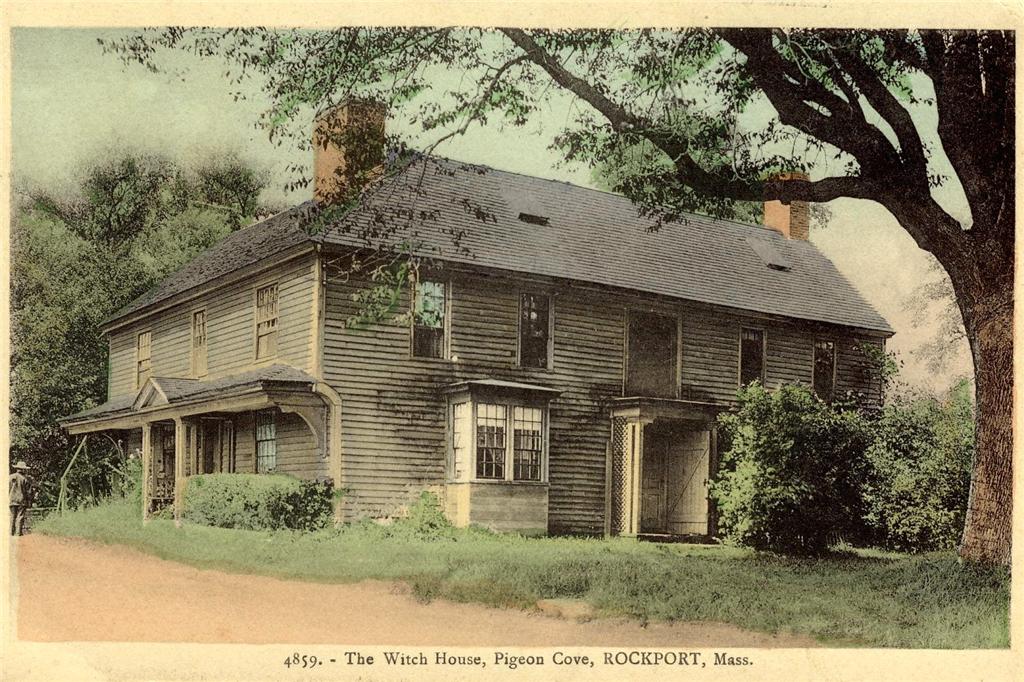
"The Witch House, Pigeon Cove,
Rockport, Mass."
circa 1912
This seems to have more credence
(although I am not able to find any Wheelers involved in the hysteria)
for the simple fact that the Witch House still stands. It was also a
popular subject of postcards as early as 1905 under that name. The folk
memory of the event remains attached to the place, and adds weight to
the story. Also, just around the corner in Pigeon cove is a Devil’s
Den, a small boulder cave on the shore. Coincidence?
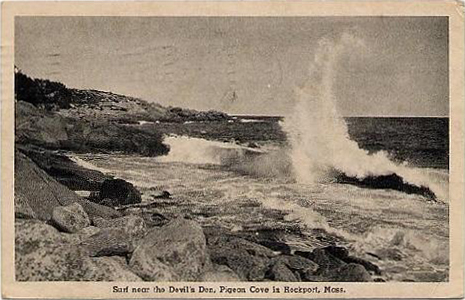
"Surf near the Devil's Den, Pigeon Cove
in Rockport, Mass."
The most famous escapees were
Phillip English and his wife. English was a well-to-do Salem Town
merchant. When the finger of accusation was pointed at him and his
wife, he didn’t bother to wait to see how it would all turn out in court
but simply skipped town to Boston until the hysteria had died down and
been buried.
In a sense, it was a turning
point in the whole affair. It was all well and fine if the lower ranks
of society, and a handful farmers and their wives were executed, but
when the fingers started turning towards the elite classes (for instance
when Governor Phips’s wife was accused),
the whole thing started grinding to a halt. Phips, for one, was not
amused, and the hangings were over.
Governor Phips, an ill-educated
fellow with "the manners of a 17th century sea captain,"
appointed upon arrival in May the special Court of Oyer (to hear) and
Terminer (to decide) to hear the witchcraft cases. Considered unfit for
his position, he did nothing to stop the witchcraft mania and executions
and only suspended the court in October after his own wife had been
accused.
Salem End Road: Building a Community
Having survived the winter in
the caves, the spring of 1693 brought new hope and a new start for the
Cloyes. Danforth gave them permission to build a house on his land and
that year they constructed a new house for themselves on Plantation
property.
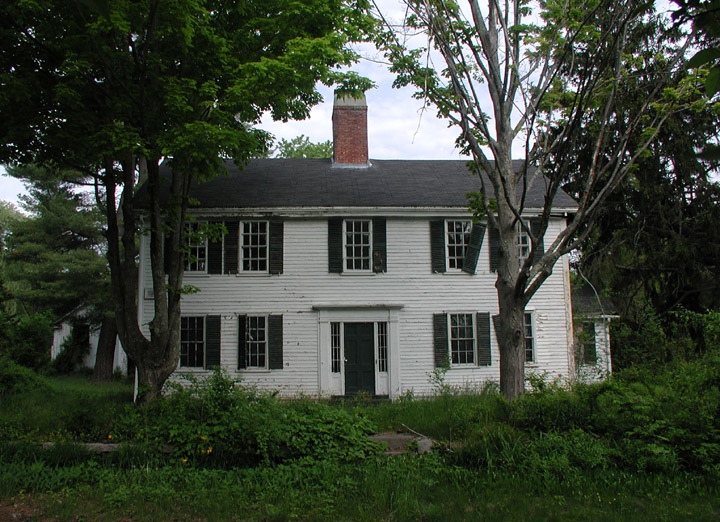
Peter & Sarah Cloyes Homestead
Herring comments on the
location, "There was the Cowasock Brook**
nearby and a relatively friendly Indian village. Just across what
must’ve been a trail then
(now Salem End Road), there’s an enormous
glacial boulder you can see today that probably served as a good
landmark." This boulder is the
one that escaping families looked for.
**
Cowasock Brook
was probably named after the Indians of the nearby
Praying Indian
Village of Magunkaquog, the "place of great trees" near Magunco
Hill in Ashland. It is possible this tribe still exists, as there
is a Pennacook Abenaki band in New Hampshire called the Cowasuck, the
"People of the White Pines." (Click
for the Cowasuck website.) The white pines are the tallest
trees in New England.
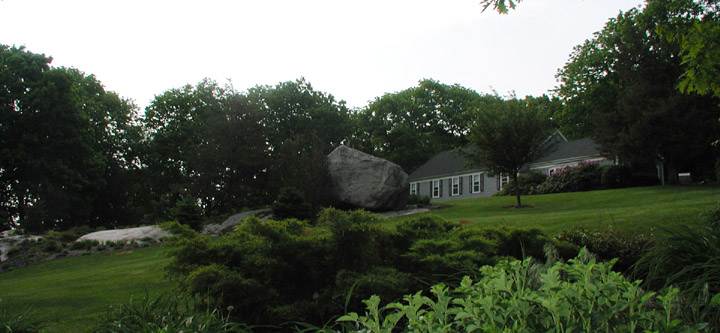
Danforth Plantation Boulder, Salem End
Road
The initial trickle of escapees
intensified to a migration, and by 1700 when Peter signed the township
petition for Framingham, at least 50 people related to the Towne sisters
had re-settled from the Salem Village area to the Salem End Road
district, with more than 800 acres given away to them by Danforth.
Among the new arrivals included the families of Sarah’s two sons from
her first marriage, Caleb and Benjamin, Benjamin arriving in the spring
of 1693, with Caleb following shortly thereafter.
Rebecca’s youngest son Benjamin
Nurse also relocated with his family in 1693, as did Mary’s son John’s
Easty and his family a few years later.
The Towne family was also
represented early in the migration. Lt. John Towne and his son Israel
Towne both relocated their families by 1698 and built on Danforth-gifted
land. Lt. John, one of Framingham’s original selectmen, was the son of
the Towne sister’s brother. Needless to say, grandniece Rebecca (Towne)
Knight did not join them in Salem End Road.
|
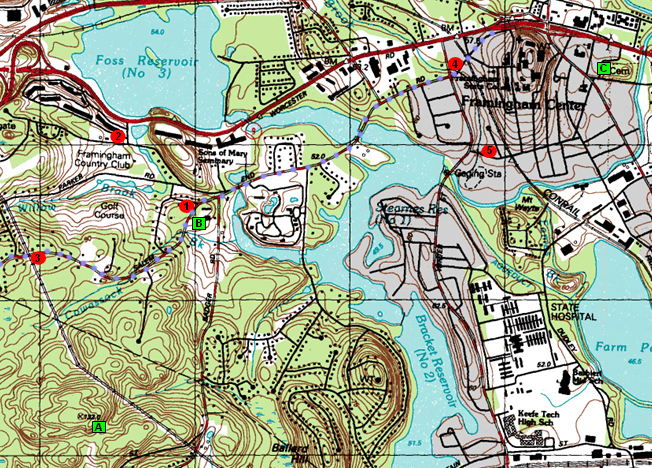 |
Map of Salem End Road Area
•
Red Dot #1:
Peter & Sarah Cloyes house
•
Red Dot
#2: Caleb Bridges house
•
Red Dot
#3: Benjamin Nurse house
•
Red Dot #4: Israel Towne house
•
Red Dot
#5: John Towne house
■
Green
Square #A: Witch Caves
■
Green Square
#B: Danforth Boulder,
signals
entering Danforth save zone
■
Green
Square #C: Framingham Old Burying Ground
•
Blue Dot
Road: Salem End Road
Click on map for large scale view |
The Nurses changed the spelling
of their name to Nourse to distance themselves from Salem, and if you
examine Framingham’s Old Burying ground, you will find many Towne, Nourse, Bridges, Easty, and Cloyes
names represented throughout the years. (One Cloyes, John,
was struck down
by lightening in 1777.)
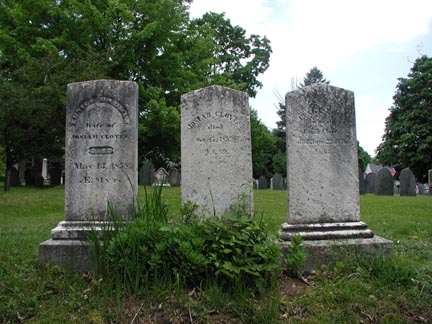
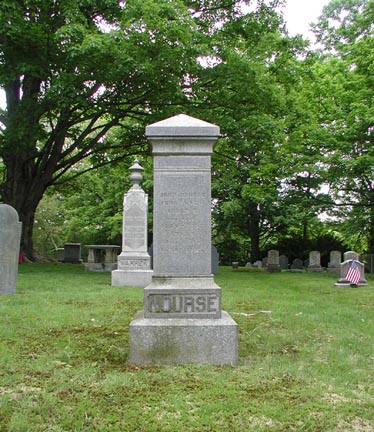
Cloyes graves, and Nourse (Nurse)
family marker
Old burying Ground, Framingham
The Townes did not stay long in the area, but the other "witch"
names became part of the founding fabric and ongoing life of the town,
and descendents still live there. The earliest existing grave marker
left of the original émigrés is that of Benjamin Bridges who died in
1723. This marker, a rough field stone with the crudely cut epitaph,
reads, "When he served his generation, by the will of God he fell
asleep."
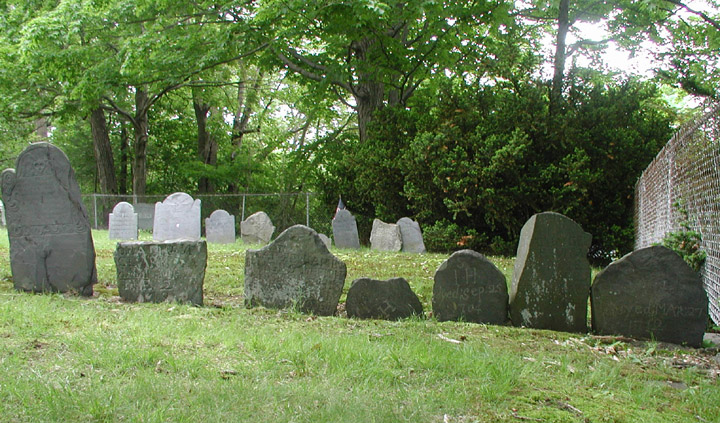
Benjamin Bridges, 3rd stone from left
click for
close-up
The Five Witch Houses of Framingham
Of the original escapees who
built in the Salem End Road community, a surprising five of these houses
still remain, representing 4 of the 5 families involved. Sarah and
Peter Cloyes’s 1693 house stands on Salem End Road. Caleb Bridges’
house is on Gates Street. The 1694 Benjamin Nurse homestead is on Salem
End Road. John Towne’s 1698 home is on Maple Street, and his son
Israel’s pre-1709 home stands on Salem End Road. Only the home of John
Easty is no longer standing.
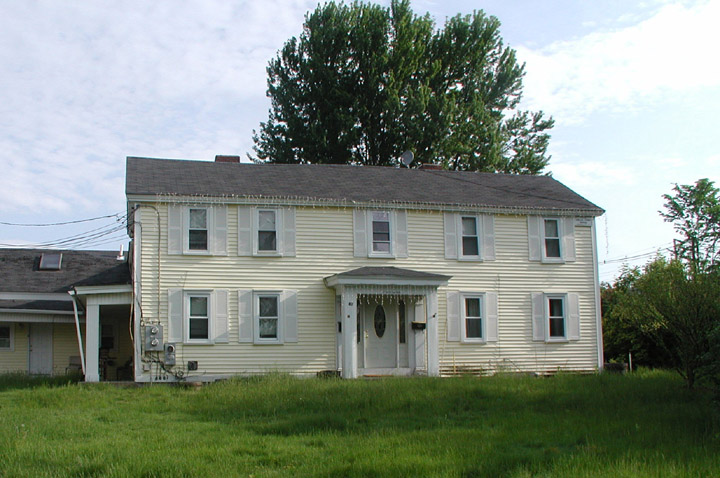
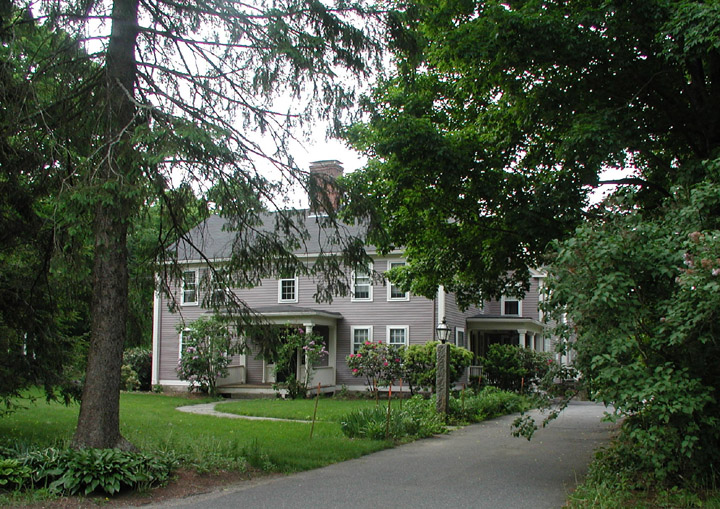
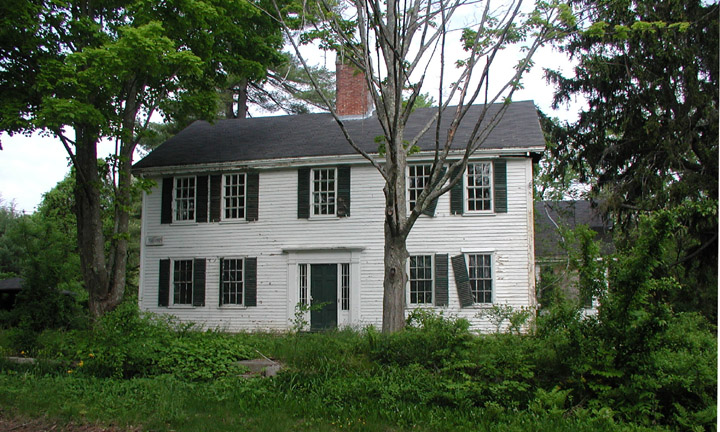
Israel Towne house - Nurse Homestead -
Peter & Sarah Cloyes house
Salem End Road ~ Framingham & Ashland
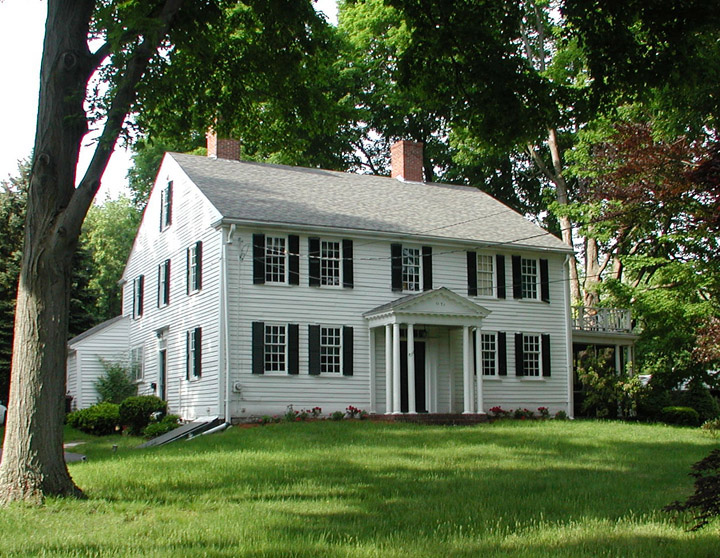
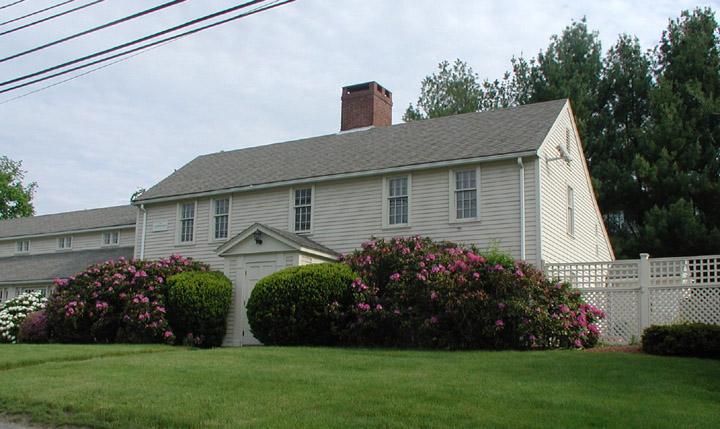
John Towne house, Maple Street & Caleb
Bridges house, Gates Street
Framingham
Yet the Eastys were definitely
in Salem End early on. According to Hurd’s 1888 History of Essex
County, "The larger part of the [Easty] family moved to Framingham
after the execution of the wife and mother, hoping they had escaped the
laws of Massachusetts, but subsequently found that they were still in
the hated State; but they had cleared away too many fields to take up
stakes again, and have remained, some of them to this present day."
Three Sovereigns For Sarah
After the court of Oyer and
Terminer was dissolved, and all the witchcraft cases cycled through by
May of 1693, the processes of petitioning for compensation and
overturning the earlier verdicts began. At the fore of this effort was
Mary’s husband, Issac Easty. It took almost 20 years, but on October
17, 1710, the General Court passed an act that, "the several
convictions, judgments, and attainders be, and hereby are, reversed, and
declared to be null and void." Further, on December 17, 1711,
Governor Dudley issued a warrant awarding Issac 20 pounds sterling in
compensation for the injustice of the 1692 verdict against Mary. Mary’s
sister Sarah received 3 gold Sovereigns, each worth ¼ of a pound. Sarah
retrieved them herself, in her first and only return to Salem.

Gold Sovereign 1643 Charles I
60 shilling piece
Abigail Hobbs, Again
Having started with Abigail
Hobbs, the self confessed teen-witch of Topsfield, let’s finish with
her. In a strange and perverse twist, the damages paid in 1711 went not
only to the victims, but also to the accusers. Abigail, whose
obsession with being a witch and whose testimony was a nail in the
coffins of so many innocent people, was awarded 10 pounds sterling as "restitution."
Restitution for what?
Email Daniel V.
Boudillion

Back to Field
Journal
Copyright © 2007, 2009 by Daniel V. Boudillion
| 













 Gallows
Hill: Where Were the Witches Really Hung? by D. V.
Boudillion
Gallows
Hill: Where Were the Witches Really Hung? by D. V.
Boudillion

































